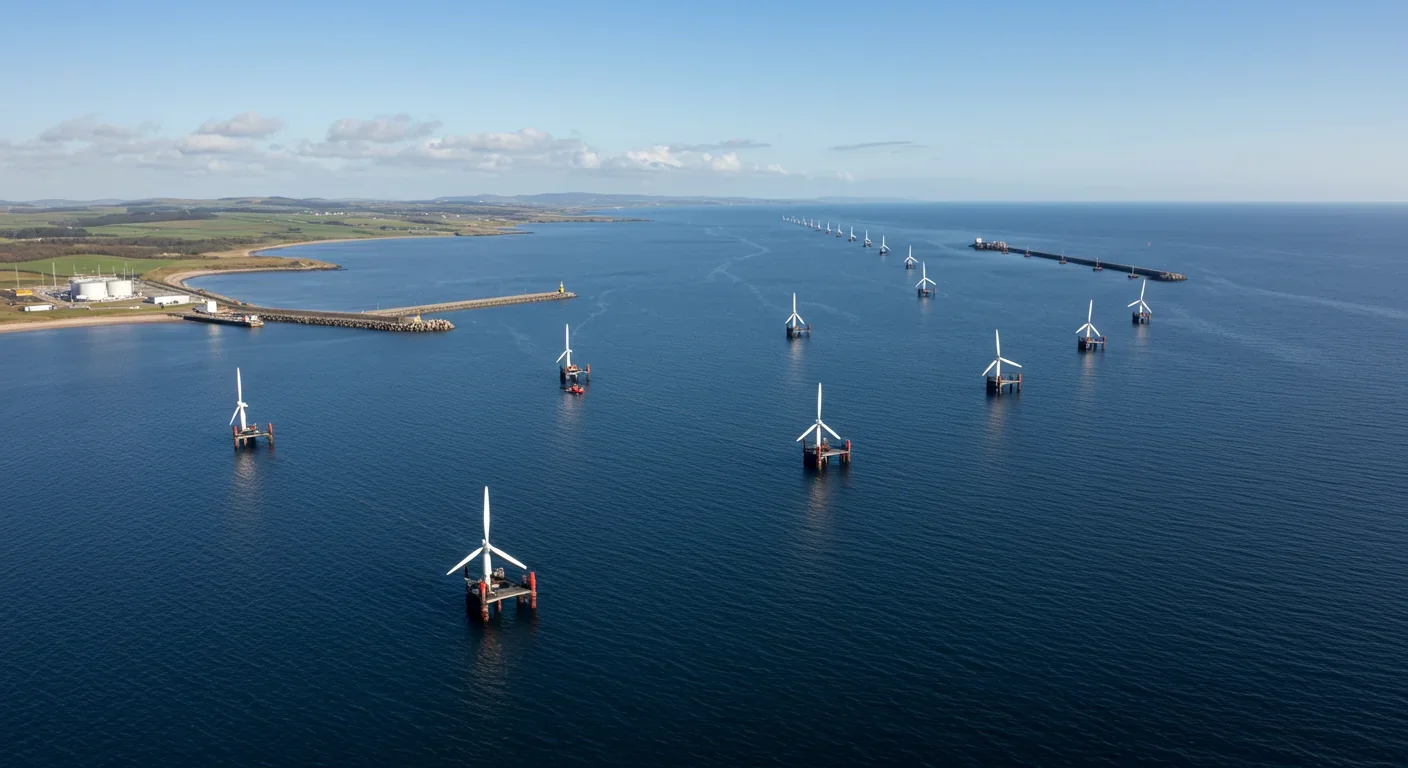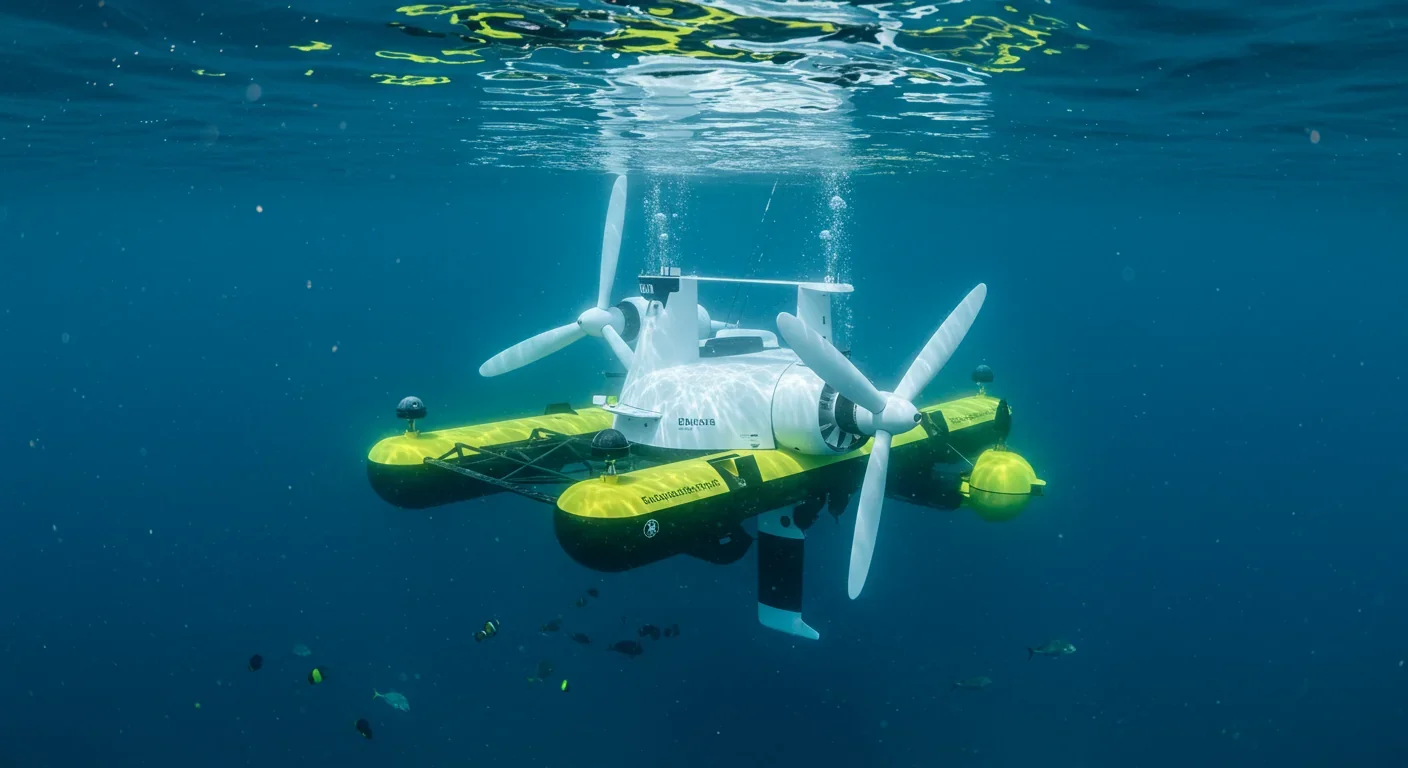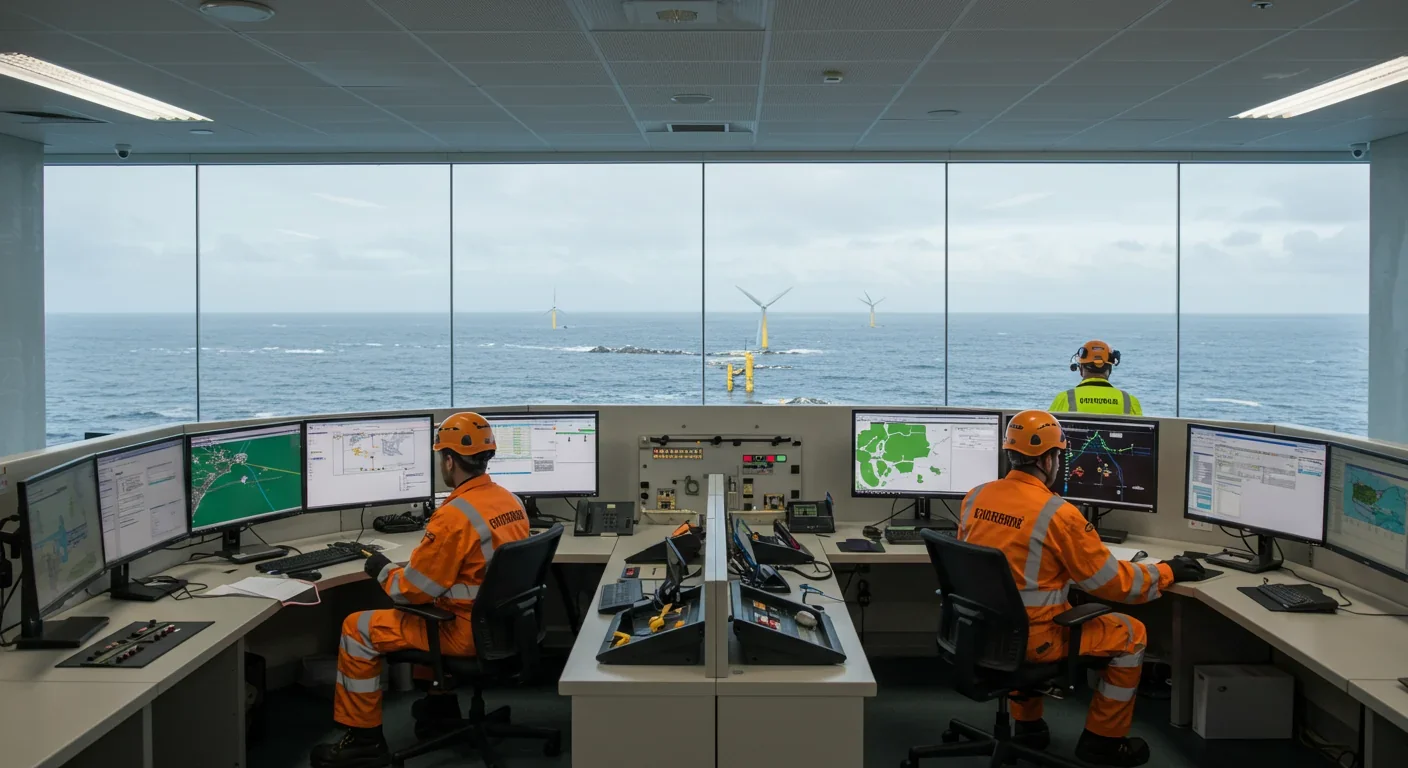Mycelium Packaging Replacing Styrofoam: Fungal Revolution

TL;DR: Tidal energy farms harness the moon's gravitational pull to generate predictable, round-the-clock electricity with zero emissions. Scotland's MeyGen turbines have run for six years without maintenance, proving the technology's durability in harsh marine environments. While high upfront costs and limited suitable sites pose challenges, the UK, France, and emerging players are scaling deployments through government subsidies and innovative designs. With 100% predictable output, tidal power offers baseload renewable energy that complements intermittent solar and wind, positioning ocean currents as a cornerstone of future carbon-free grids.

By 2030, the world's oceans could power 10 million homes through a technology that operates 24/7, never stops for cloudy weather, and can be predicted with near-perfect accuracy a century in advance. Unlike the solar panels and wind turbines dominating today's renewable headlines, tidal energy farms tap into gravitational forces so reliable that coastal engineers can schedule maintenance years before it's needed. Scotland's MeyGen array has already proven the concept: four underwater turbines spinning continuously for eight years, generating enough electricity for 7,000 homes without a single unplanned shutdown. The turbines work like clockwork because the moon's pull on Earth's oceans follows laws of physics, not the whims of weather patterns.
In July 2025, engineers at Scotland's Pentland Firth celebrated a milestone that changes everything for renewable energy economics. One of MeyGen's 1.5-megawatt turbines completed 6.5 years of continuous operation—submerged 40 meters below the surface in one of the world's most punishing marine environments—without requiring a single repair. The bearings, seals, and drive systems supplied by SKF endured salt water, extreme pressure, and tidal currents reaching 4 meters per second, all while generating electricity through 12 to 18 blade rotations per minute.
This durability record matters because maintenance costs have historically killed tidal projects. Early prototypes required expensive retrieval every few years, making them financially unviable compared to offshore wind. "That's a very significant milestone that bodes well for the future of tidal energy," Rémi Gruet, CEO of Ocean Energy Europe, told Euronews. Andrea Copping, a University of Washington marine energy expert, added: "Skeptics, including investors, said 'How on Earth are you going to operate these things for any length of time in this very tough environment?' And that's what I think they proved."
The achievement validates a decade of engineering refinement. MeyGen's four turbines collectively generated 51 gigawatt-hours in 2022—enough to power roughly 6,000 homes annually. By comparison, France's La Rance tidal barrage, operating since 1966, produces 500 gigawatt-hours per year at 240 megawatts capacity. The difference lies in scale: La Rance spans a 750-meter barrage across an estuary, while MeyGen's turbines sit on the seabed like underwater wind farms, leaving shipping lanes clear and marine habitats largely undisturbed.
The fundamental advantage of tidal energy lies in celestial mechanics. Earth's oceans rise and fall in response to gravitational forces exerted by the moon and sun—forces that follow mathematical precision. Oceanographers can forecast tidal patterns decades in advance with accuracy that makes weather prediction look like guesswork. "Tidal power offers 100% predictability," Gruet explains. "We can tell very precisely how much energy can be produced even ten years from now at a specific date and time."
This predictability solves a critical problem for grid operators. Solar farms go dark at night and dim during storms. Wind turbines idle when air currents drop. Battery storage helps, but costs remain high. Tidal energy, by contrast, delivers power in cycles that grid managers can integrate into dispatch schedules months before demand peaks. The tides reverse twice daily, but they're never intermittent—they're completely reliable, according to research on variable renewable energy sources.
The physics amplifies efficiency. Water is roughly 800 times denser than air, so tidal turbines generate comparable power to wind turbines at one-tenth the velocity. A tidal current flowing at 2.5 meters per second delivers as much kinetic energy as a 25-meter-per-second wind gust. This density advantage allows smaller rotor diameters: MeyGen's turbines use 16-meter blades, while offshore wind turbines stretch beyond 100 meters. The compact footprint reduces material costs and simplifies underwater installation.
Tidal energy farms harvest power through two main approaches: barrages and stream generators. Barrages function like hydroelectric dams built across estuaries or bays. As tides flood in, water fills a reservoir behind a low dam wall equipped with sluice gates. When the tide ebbs, the impounded water rushes back through turbines embedded in the barrage, spinning generators that feed electricity to the grid. France's La Rance plant pioneered this method in 1966, using 24 bulb Kaplan turbines rated at 10 megawatts each. South Korea's Sihwa Lake barrage, commissioned in 2011, surpassed La Rance with 254 megawatts capacity, supplying power to over 500,000 homes.
Barrages deliver massive capacity but come with environmental trade-offs. Blocking tidal flows alters sediment transport, changes salinity gradients, and disrupts fish migration routes. The La Rance barrage caused progressive silting that eliminated sand-eels and plaice from the Rance ecosystem, though sea bass and cuttlefish populations rebounded. These ecological impacts, combined with construction costs reaching €94.5 million (in 1960s currency), explain why only two large-scale barrages operate commercially worldwide.

Tidal stream generators offer a less invasive alternative. These devices resemble underwater wind turbines, with axial-flow rotors mounted on seabed foundations or floating platforms. Water currents spin the blades, driving generators through gearboxes designed for bidirectional flow—ebb and flood tides turn rotors in opposite directions. SeaGen, installed in Northern Ireland's Strangford Lough in 2008, became the world's first commercial-scale tidal stream device to feed electricity into a national grid. Its twin 16-meter rotors generated 1.2 megawatts, achieving a capacity factor of 59% over 18 to 20 hours of daily operation.
Modern designs push efficiency further. Orbital Marine Power's O2 turbine, deployed at Scotland's European Marine Energy Centre in 2021, uses a floating platform with retractable legs. The gull-wing design allows the 680-tonne structure to surface for maintenance in under 40 minutes, eliminating the need for heavy-lift vessels. Four-point catenary mooring chains withstand loads equivalent to lifting over 50 double-decker buses, anchoring the turbine through Atlantic storms. At 2 megawatts rated output, the O2 generates 3 to 4 gigawatt-hours annually—a 20% capacity factor comparable to early offshore wind projects.
Grid integration follows standard practices for variable renewables. Tidal turbines connect through subsea cables to onshore substations, where inverters convert direct current to alternating current at grid frequency. Because tidal cycles create predictable peaks and troughs in generation, operators pair tidal farms with battery storage or dispatch them alongside natural gas peakers to smooth output. Scotland's MeyGen site links directly to the national grid via a 33-kilovolt export cable. Expansion plans hinge on grid upgrades: MeyGen aims to install 20 additional turbines by 2030, contingent on transmission capacity improvements.
Tidal energy's societal impact extends beyond kilowatt-hours. The sector creates skilled jobs in coastal regions often overlooked by high-tech industries. Turbine manufacturing, subsea installation, marine surveying, environmental monitoring, and O&M roles require welders, engineers, technicians, and divers. Scotland's tidal sector, concentrated in Orkney and the Pentland Firth, has spurred industrial clusters that attract investment from global engineering firms. When the Welsh Government allocated £10 million to the Morlais tidal project in 2025, officials highlighted the dual benefit of grid capacity expansion and regional job creation.
Energy security gains matter for nations dependent on fossil fuel imports. Small island communities face particular vulnerabilities: diesel generators dominate electricity in remote archipelagos, exposing residents to volatile fuel prices and supply chain disruptions. The Faroe Islands plan to deploy 200 megawatts of tidal kite arrays by 2030, aiming to supply 40% of national electricity demand. Minesto's Dragon 12 kites, each generating 1.2 megawatts, operate in currents as slow as 1.3 meters per second by flying figure-eight patterns that amplify relative water speed tenfold. This autonomous control technology unlocks sites previously considered unsuitable, broadening tidal energy's geographic reach.
Cultural shifts accompany technological adoption. Coastal communities historically lived by tidal rhythms—fishing fleets departed with ebbing tides, and tide mills ground grain when reservoirs filled. Modern tidal farms reconnect people to lunar cycles in a new context: electricity bills tied to gravitational astronomy. Public acceptance runs higher than for onshore wind farms because underwater turbines produce minimal visual impact. Orbital's O2 sits entirely submerged except during surface maintenance, and acoustic monitoring shows operational noise stays below 10 decibels beneath marine ambient thresholds, reducing disturbance to marine mammals.
The educational ripple effects shouldn't be underestimated. Schools near tidal projects incorporate marine energy into STEM curricula, inspiring students to pursue careers in oceanography, mechanical engineering, and environmental science. The European Marine Energy Centre in Orkney has become a living laboratory, hosting university research teams and industry prototypes at pre-consented test sites. This knowledge infrastructure accelerates innovation: when California launched its marine energy assessment in 2024, planners studied Orkney's regulatory model to reduce permitting barriers for wave and tidal developers.
Tidal energy solves problems that plague other renewables. Solar and wind generate intermittently, forcing grid operators to maintain backup capacity—often natural gas plants that emit carbon dioxide. Tidal farms, by contrast, deliver predictable baseload power. A tidal lagoon with pumped storage capability can generate continuously by strategically releasing impounded water during both high and low tides, achieving capacity factors above 50%. Dual-basin designs, which use separate reservoirs at different elevations, enable near-constant generation but require longer dam infrastructure.
The carbon footprint tilts heavily favorable. Manufacturing turbines and laying subsea cables consume energy, but operational emissions are zero. Over a 25- to 30-year lifespan—or 120 years for barrages—tidal farms deliver electricity at lifecycle carbon intensities competitive with nuclear power and far below coal or gas. La Rance has operated since 1966 with minimal greenhouse gas output, and its electricity now costs less per kilowatt-hour than nuclear plants in EDF's portfolio. This longevity transforms high upfront capital costs into long-term value.
Artificial reef effects provide an unexpected ecological bonus. Turbine foundations and subsea structures attract marine life, functioning as artificial reefs that enhance local biodiversity. Observations around MeyGen's turbines show increased fish populations, challenging the narrative that tidal infrastructure only harms ecosystems. Fish-friendly designs—slower blade rotation speeds, detection systems that halt turbines when marine mammals approach—further mitigate collision risks. Three years of environmental monitoring at SeaGen in Strangford Lough detected no major impacts on marine mammals, and hydroacoustic sensors found negligible fish presence in blade zones.
Hybrid renewable systems multiply benefits. Pairing tidal farms with offshore wind creates complementary generation profiles: tidal peaks often occur when wind lulls, and vice versa. Adding battery storage smooths intermittency entirely, enabling tidal-wind-storage systems to provide firm baseload capacity that displaces fossil peakers. Pilot projects in Europe integrate tidal turbines with hydrogen electrolyzers, producing green hydrogen during off-peak grid demand. This tidal-to-hydrogen pathway offers a storage mechanism for intermittent renewables, converting excess tidal power into transportable fuel.
Dual-purpose infrastructure amplifies economic returns. Tidal barrages double as flood defenses, protecting low-lying coastal areas from storm surges and sea-level rise. The environmental benefits extend beyond electricity: barrages with two-way generation maintain the full tidal range within impoundments, preserving saltmarshes and mudflats that serve as critical habitats. Tidal lagoons, which enclose smaller areas than full barrages, reduce ecological disruption while offering flood protection and recreational opportunities—marinas, nature reserves, and waterfront development can coexist with power generation.
High upfront capital expenditures remain tidal energy's Achilles' heel. Installing a tidal barrage costs hundreds of millions: La Rance's 1966 construction consumed ₣620 million (roughly €94.5 million), taking nearly 20 years to recoup. Stream generator projects run cheaper but still dwarf solar or onshore wind on a per-megawatt basis. India's proposed 50-megawatt tidal plant in the Gulf of Kutch carries an estimated cost of ₹7.5 billion—₹150 million per megawatt—far exceeding the ₹35 million per megawatt for solar photovoltaics. The Ministry of New and Renewable Energy labeled tidal power "prohibitively expensive" and classified India's 12.45-gigawatt theoretical tidal potential as purely academic.
Maintenance challenges multiply underwater. Saltwater corrosion attacks metal components, marine biofouling clogs intakes and fouls sensors, and extreme pressures stress seals and bearings. Early tidal turbines required retrieval every few years for refurbishment, sending costs skyrocketing. The six-year MeyGen record demonstrates that durability is achievable, but component reliability depends on precision manufacturing. SKF's specialized bearings for the MeyGen turbines incorporate advanced seals rated for depths nearing 100 feet and tidal flow speeds around 6 knots—engineering that doesn't come cheap.

Environmental risks demand rigorous mitigation. Large barrages alter entire estuaries, changing tidal ranges, sediment deposition, and salinity. Fish migrations disrupt when dams block spawning routes, and slow-moving turbines still pose collision risks during high-traffic periods. Dual-basin lagoons reduce some impacts by maintaining partial tidal exchange, but no design entirely eliminates ecological trade-offs. Regulatory hurdles reflect these concerns: permitting a tidal project requires multi-year environmental impact assessments, navigation safety reviews, and stakeholder consultations with fishing communities, conservationists, and port authorities.
Scalability constraints limit where tidal farms can deploy. Only about 3% of the global ocean's 3,000-gigawatt theoretical tidal potential sits in economically viable locations—sites with strong currents, shallow depths, and proximity to grid infrastructure. The UK possesses roughly 20 gigawatts of tidal range resource and 11 gigawatts of tidal stream capacity, but most nations lack comparable geography. Narrow straits, estuaries with extreme tidal ranges, and channels between islands concentrate the opportunity. The Bay of Fundy in Canada, the Pentland Firth in Scotland, and the Severn Estuary in the UK represent prime locations, but global deployment faces geographic ceilings absent in solar and wind.
Financing gaps slow commercialization. Tidal projects fall into a valley of death: too capital-intensive for venture capital, too risky for infrastructure funds accustomed to proven technologies. Crowdfunding has filled part of the gap—ocean energy startups raised $69 million from 30,000 investors over the past decade—but Christopher Milne, CFO at Orbital Marine Power, notes that "fundraising for ocean energy is inherently more difficult than in other tech sectors." Most tidal developers rely on government subsidies: the UK's Contracts for Difference scheme allocated £45 million across three rounds, France secured €51 million in EU Innovation Fund grants for two tidal farms, and Canada committed $10.7 million to Bay of Fundy projects.
The United Kingdom dominates tidal energy development, accounting for 28 of the world's 74 tracked projects—nearly 40% of the global pipeline. Scotland hosts 14 projects, including MeyGen's planned 398-megawatt expansion. The UK government introduced ring-fenced Contracts for Difference allocations in 2022, offering strike prices of £178.54 per megawatt-hour—triple the wholesale electricity price but sufficient to de-risk investment. Subsequent rounds reduced strike prices to £172 per megawatt-hour by 2024, reflecting cost declines of 30% over the past decade. Industry analysts project further reductions to £100 per megawatt-hour by 2030 as turbine designs standardize and supply chains mature.
France trails closely, leveraging its long history with La Rance. The European Commission awarded €31.3 million to the NH1 tidal farm and additional funding to HydroQuest's 17-megawatt FloWatt project, both expected operational by 2028. French engineers pioneered bulb Kaplan turbines—submerged generators with streamlined housings that minimize flow disruption—and that expertise now informs next-generation designs. Europe's broader commitment includes a 1-gigawatt ocean energy target by 2030 and 40 gigawatts by 2040, backed by feed-in tariffs, tax incentives, and grant programs under Horizon Europe.
Asia presents a mixed picture. South Korea operates the world's largest tidal barrage at Sihwa Lake, generating 552 gigawatt-hours annually with a flood-generation system that captures incoming tides. China commissioned a 3.4-megawatt tidal project in Zhejiang Province in 2023, part of national carbon neutrality targets, and deployed the Endeavor megawatt-scale turbine near Xiushan Island. However, India remains sidelined by cost concerns: despite a 54-gigawatt theoretical ocean energy potential, the Ministry of New and Renewable Energy considers tidal power economically impractical without breakthroughs in capital cost reduction.
North America explores cautiously. Canada's Bay of Fundy, home to the world's highest tides, attracted $10.7 million in federal funding for environmental monitoring and fish-collision studies, laying groundwork for future deployments. The United States lags in tidal development but leads in wave energy research: California's wave resources alone could generate 140 terawatt-hours per year—23% of state electricity demand—prompting a legislative mandate to assess marine energy integration. PacWave South, a pre-permitted test site in Oregon, will accommodate 20 megawatts of wave converters, offering a regulatory model that tidal developers hope to replicate.
International cooperation accelerates technology transfer. The International Electrotechnical Commission's Renewable Energy division (IECRE) issues feasibility statements and certification pathways that reduce investor risk. Orbital Marine Power's O2-X turbine received an IECRE Feasibility Statement in February 2025, validating its design for commercial deployment. Certification acts as a trust mechanism, bridging the gap between prototype development and regulatory acceptance. As more turbines earn certification, supply chains consolidate, manufacturing scales, and costs decline—a virtuous cycle that mirrors offshore wind's trajectory from niche to mainstream.
Policymakers must prioritize streamlined permitting without compromising environmental safeguards. Pre-consented test sites like EMEC's Fall of Warness and California's PacWave South dramatically lower barriers for developers, enabling rapid design iteration. Governments can expand this model by designating marine energy zones with baseline environmental assessments already complete, much as offshore wind lease areas expedite turbine installations. Feed-in tariffs and power purchase agreements provide revenue certainty, while R&D funding drives component innovation—materials resistant to biofouling, bearings that withstand decades underwater, and turbine designs optimized for low-velocity currents.
Investors should recognize tidal energy's distinct risk profile. High capital costs and long payback periods suit patient capital: pension funds, sovereign wealth funds, and green bonds aligned with 20- to 30-year horizons. The predictability of tidal generation reduces revenue volatility compared to wind or solar, appealing to institutional investors seeking stable returns. Early movers gain strategic advantage as supply chains develop—turbine manufacturers, subsea cabling specialists, and marine contractors will consolidate around successful projects, creating incumbent advantages.
Engineers and entrepreneurs face massive opportunities in component innovation. Challenges remain in biofouling prevention, corrosion-resistant alloys, subsea robotics for autonomous inspection, and AI-driven predictive maintenance. Minesto's tidal kite demonstrates how biomimicry—emulating underwater flight—unlocks low-velocity sites. Other startups pursue vertical-axis turbines that self-orient with changing currents, floating platforms that reduce seabed disruption, and hybrid systems that combine tidal, wind, and wave capture on shared offshore structures. Each innovation inches the industry toward cost-competitiveness.
Coastal communities should engage proactively in marine spatial planning. Tidal farms compete with fishing grounds, shipping lanes, and conservation areas, but early dialogue can identify compatible uses. Some turbine designs incorporate artificial reefs that enhance fisheries, turning infrastructure into ecological assets. Community benefit schemes—modeled on onshore wind's local ownership models—can distribute revenue to residents near tidal sites, building social license and ensuring energy transition benefits reach those most affected.
Educational institutions must expand marine energy curricula. The sector needs naval architects, oceanographers, electrical engineers, environmental scientists, and project managers fluent in the unique demands of underwater energy systems. Universities in Scotland, France, and Canada lead in marine energy research, but global talent pools remain shallow. Scholarships, industry partnerships, and hands-on training at test facilities will cultivate the workforce needed to deploy gigawatts of tidal capacity over the next two decades.
Tidal energy farms represent more than an alternative power source—they embody a fundamental shift in how humanity relates to planetary forces. For millennia, sailors timed voyages by tides and millers ground grain when the moon pulled water through sluices. Industrial civilization broke that connection, burning ancient carbon stored over geological epochs. Tidal farms reconnect us to rhythms older than civilization itself, harvesting energy from gravitational dances between celestial bodies.
The technology isn't perfect. Capital costs remain high, suitable sites are geographically limited, and ecosystem impacts require careful management. But the six-year reliability milestone at MeyGen, the declining cost curve in the UK, and the expansion plans across Europe and Asia signal that tidal energy is transitioning from experimental to commercial. When the Faroe Islands power 40% of homes with tidal kites, when Scotland's Pentland Firth hosts 398 megawatts of subsea turbines, and when France replicates La Rance's success at scale, the world will witness baseload renewable power that operates with the certainty of celestial mechanics.
The moon will rise tomorrow night, and the night after, pulling tides across coastlines with forces that dwarf human engineering. The question isn't whether that energy exists—it's whether we possess the vision to harness it. As climate targets tighten and fossil fuel phase-outs accelerate, tidal farms offer grid operators a rare gift: predictable, zero-carbon electricity that complements wind and solar without replicating their intermittency challenges. The ocean's rhythms have shaped life on Earth for billions of years. Now, they're poised to power the next century of human civilization—one lunar cycle at a time.

Wormholes collapse instantly because they require exotic matter with negative energy that doesn't exist in useful quantities, and quantum instabilities destroy them faster than light can cross their throats, making spacetime shortcuts a physics impossibility.

Scientific studies reveal electromagnetic hypersensitivity sufferers experience genuine symptoms but cannot detect EMF exposure better than chance, pointing to the nocebo effect rather than electromagnetic fields as the primary cause.

Mycelium packaging grows from agricultural waste in days, decomposes in weeks, and is already shipping in Dell computers and IKEA furniture—proving fungi can replace foam.

Our attraction to impractical partners stems from evolutionary signals, attachment patterns formed in childhood, and modern status pressures. Understanding these forces helps us make conscious choices aligned with long-term happiness rather than hardwired instincts.

Virtual reality experiments are revealing how honeybees form sophisticated cognitive maps with brains smaller than sesame seeds, revolutionizing our understanding of intelligence and inspiring energy-efficient robots while guiding pollinator conservation.

Millions of student loan borrowers are refusing to repay as an organized protest against a $1.77 trillion debt system they view as exploitative. With one in three borrowers at risk of default by 2025, this movement challenges whether the entire higher education financing model can survive.

Blockchain-based social networks like Bluesky, Mastodon, and Lens Protocol are growing rapidly, offering user data ownership and censorship resistance. While they won't immediately replace Facebook or Twitter, their 51% annual growth rate and new economic models could force Big Tech to fundamentally change how social media works.